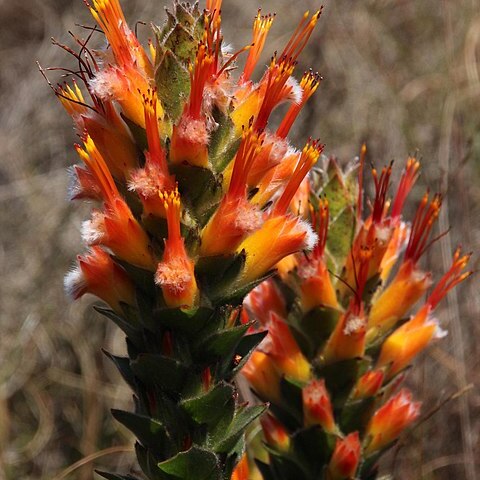An erect rounded shrub to 2 m, with a single main stem; crown compact, densely branched; with age developing several erect, usually unbranched straggling shoots. Branches 5-8 mm in diam., villous initially, later glabrous. Leaves ascending imbricate, lanceolate to broadly lanceolate to ovate, 20-35 mm long, 8-20 mm wide, sharply acute, entire, with a single thickened apical callus; hispidly villous initially, later glabrescent. Inflorescence cylindric, 60-100 mm long, 60-80 mm wide, terminated by an erect shoot of foliage leaves, not differentiated into a distinct coma. Capitula 10 to 13, usually 11-flowered; subtended by a broadly ovate foliage leaf occasionally tinged carmine during anthesis, 25-40 mm long, 15-20 mm wide, very densely hispid, margins hispidly ciliate. Outer involucral bracts very narrowly lanceolate to linear, 15-25 mm long, 3-6 mm wide, erect and ascending, greenish-white, carmine-flushed, tomentose; inner bracts lanceolate to broadly lanceolate, sharply acute, 15-40 mm long, 8-14 mm wide, orange-red, hyaline and glabrous proximally, softly puberulous distally. Floral bracts narrowly lanceolate-acute, 30-35 mm long, 5-10 mm wide, orange-red,' glabrous proximally, puberulous and ciliate distally. Perianth 30-40 mm long, tube glabrous proximally, slightly inflated, 5-7 mm long; claws filiform, sericeous, limbs linear-acute, densely sericeous. Anthers 4 mm long, sessile. Style 45-55 mm long elongating at anthesis and becoming strongly arcuate, straightening later. Pollen presenter 5-7 mm long, annulately swollen at junction with style, narrowing and becoming capitate to conic-acute at apex; stigmatic groove terminal. Ovary ovoid, 2 mm long, sericeous. Hypogynous scales linear-obtuse, fleshy, 2 mm long. Fruits cylindric, 5-6 mm long, 2-3 mm wide, minutely puberulous. Mimetes capitulatus flowers from late winter until early summer, opening towards the middle of June and continuing until December. August, however, is the peak of the flowering season. The fruits mature during summer and can be gathered from November until February, depending on local conditions.
More
Rounded, single-stemmed shrub to 2 m. Leaves ovate to lanceolate, clasping stem, sometimes spreading, shaggy; inflorescence leaves similar. Flower heads in terminal spikes, white, involucral bracts orange-red, style red with yellow tip, pollen presenter club-shaped.


